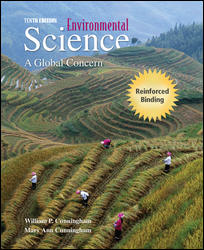1 A) Underground grain storage silos B) Irrigation circles, from center-pivot irrigators C) Grassy parks for outdoor recreation D) Exercise pens for the cattle E) Reference circles for airplanes 2 A) They are generally 0.2 mile in diameter. B) They are generally 0.5 mile in diameter. C) They are generally 1 mile in diameter. D) They are generally 1.5 miles in diameter E) They have varying diameters, between 0.5 and 2 miles in length. 3 A) The landscape is green and verdant, indicating abundant precipitation. B) The landscape is a mixture of green and brown patches, indicating varying amounts of precipitation. C) The landscape is mostly brown and dry, indicating a scarcity of precipitation, with the exception of the irrigated circles which provide most vegetation growth in this area. D) There is not enough evidence in the image to speculate about precipitation levels. 4 A) Here there are simply ponds; in conventional municipal treatment systems, there are additional buildings and equipment. B) In these ponds, natural decomposition is intended to process waste; in a conventional municipal system, aerators, filters, and other treatment methods are used to remove wastes. C) Both of the answers above are true. D) Neither of the answers above is true. E) There is no difference between this treatment system and conventional municipal treatment systems.





